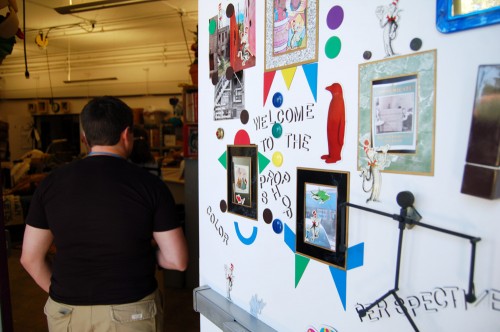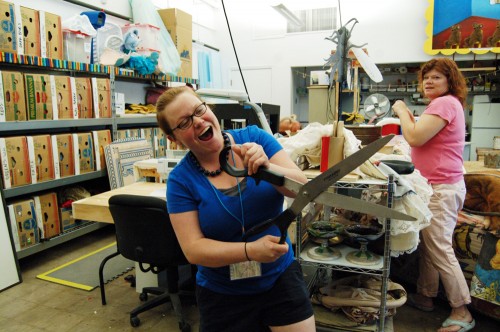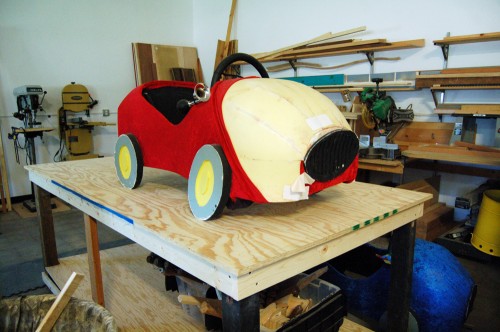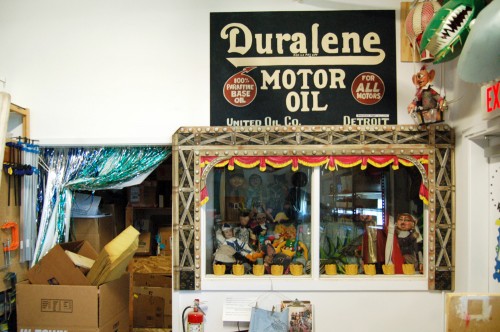I am back from the 18th (or 19th?) official S*P*A*M conference. This year’s host was Jim Luther, the Prop Director at Childsplay Theatre in Arizona. On the Saturday of the conference, he led us on a tour of his props shop and their facilities.
The front room of the shop is the “clean” room, which also had a number of props out for display. Jim showed us some pieces as we looked around.
Jim models a “Victorian exterminator’s suit” which he created for The Borrowers. Very Steampunk.
Natalie Kearns demonstrates how much fun a giant pair of scissors is.
Over in the carpentry section of the prop shop, we find a tiny red car which is in the middle of being upholstered.
In every corner which was not devoted to tools or materials, we found props from previous shows on display.
We also had the chance to peek into the prop storage room. Jim just finished moving all his props from a previous storage area in the past year, and he is going to have to move it all again before the end of this one.
Check back again at the end of the week for more photographs of the rest of Childsplay’s campus.
















Hi Eric- great posts from the conference!
Mr. Luther certainly has a ship-shape and organized prop shop. I think I might caution against one detail, though, and that is the use of cardboard boxes for long(er) term storage.
I’m the first person that can appreciate a storage method of uniform sizes, but I think I would be concerned about long term effects of the acid (or other chemical) content of the cardboard, especially on other paper products, leather, or textiles. Even plastic and metal may not be impervious, at least to potential for staining. The cheapest cardboard boxes are likely made in other countries, with methods that are sometimes less than environmentally friendly. (Every time I encounter paper made in China it smells strongly of acetone, and leaves a “oily” residue on my hands.)
Additionally, cardboard tends to be a sop for humidity, leading to mold issues which can attack materials of all kinds (even rust or other oxidation on metal items). Admittedly, Arizona doesn’t suffer so much as other parts of the country!
Inexpensive translucent plastic containers of all kinds of sizes are easily obtained and integrated into a shelf system. Being able to view the contents can either augment or replace the need for labeling. Containers that see a lot of heavy handling should of course be stouter (which usually means opaque), such as the flip-lid ‘totes’.
High humidity can still cause problems, though, so desiccant is often used to keep materials from deteriorating.
I learned this stuff the hard way, and hoped to prevent somebody else from suffering loss or a lot of clean-up work by offering my thoughts.
Thanks for all your work, Eric!
Thanks for the great words of wisdom, Brian. I’d admit we still have some things stored in cardboard boxes here at the Public. I love the plastic bins and totes, but we can only buy so many at a time with our budgets, so it’s more of a transitional process of organizing all of our items and supplies out of cardboard and into plastic.
Incidentally, do you have any experience using wood or plywood boxes as storage? Do they suffer the same problems as cardboard?
Thanks again,
Eric
Regarding the acid content of your cardboard boxes, consider Archival Polyethylene Storage Bags (available in many sizes) as a protective barrier for your more delicate items. While I have no personal experience working with plywood or wood boxes for archival storage, I believe that they are highly acidic and would need some type of barrier lining- there are barrier boards (they’re like working with heavy mat board) that could be layered and lined into a custom box- say for props that don’t fit into available plastic containers.
Love your blog!
Totally understand regarding the cost of the bins, etc. I’m just about transitioned myself but it’s been a five year process, and I don’t have near the amount of material you have at the Public. I’d say for anyone facing this to just think in terms of vulnerabilities and get the more delicate material items into plastic sooner, leaving metals and other plastics for later.
Great thought about the Polyethylene bags- it crossed my mind but since I don’t have any real experience with those I couldn’t speak to it. If using bags I’d encourage you to reuse the little desiccant bags you get with shoes, handbags, knapsacks, electronics, etc. and toss one or two in with your props.
I think Charl is right about plywood- it just stands to reason that the more ‘processed’ wood is the more likely it will have damaging chemicals in the mix.
Thanks for the pictures! I just saw this and I love the one of me with the scissors 🙂 That was a fun place! I wish I could do more TYA shows!